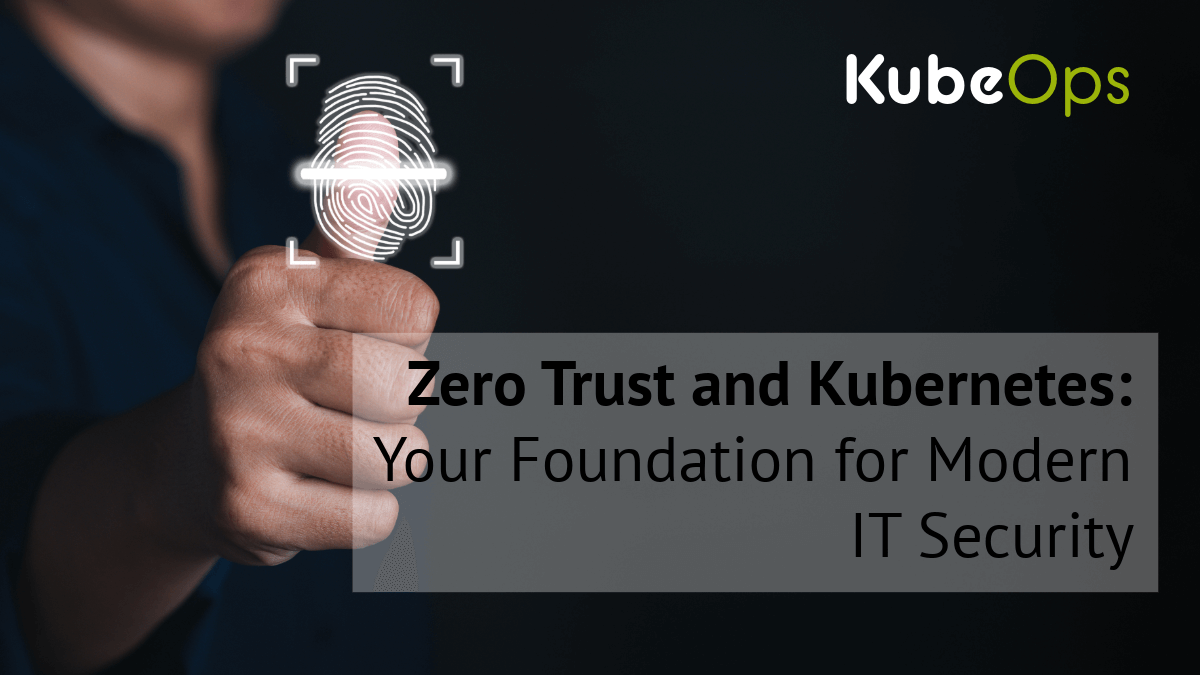Blogs
Zero Trust and Kubernetes: Your Foundation for Modern IT Security

Why Your Network No Longer Deserves Trust
In modern IT systems, there are no longer any "safe zones." Cloud services, remote work, and APIs have blurred the once-clear boundaries of networks. Every user, device, and service can potentially be a threat—whether inside or outside your network.
Zero Trust Architecture (ZTA) is based on a simple yet effective principle: "Never trust, always verify." This model protects your infrastructure by continuously authenticating and verifying every access request, no matter where it originates. Especially in Kubernetes environments, which consist of interconnected services, Zero Trust provides a secure foundation for modern IT management.
Kubernetes and Zero Trust: Why They’re a Perfect Match
Kubernetes is the standard for orchestrating applications, but it also brings new security challenges:
- Dynamism: Services scale up and down automatically.
- Distribution: Applications communicate over networks, often through public cloud providers.
- Complexity: Numerous APIs and user accesses increase the attack surface.
Zero Trust addresses these challenges by:
- Securing communication: Traffic between services is protected through encryption and authentication (e.g., using mTLS).
- Network segmentation: Kubernetes Network Policies limit traffic to what is absolutely necessary.
- Least privilege: Every component gets only the permissions it truly needs.
Technical Measures in Detail
-
Network Protection Through Segmentation and Policies:
- Kubernetes Network Policies allow fine-grained control over traffic between pods.
- Example: Block all traffic by default, and explicitly allow communication between services, e.g., between frontend and backend pods.
- Tools like Calico extend these capabilities by providing real-time network monitoring and anomaly detection.
-
Securing Communication with mTLS:
- Mutual TLS (mTLS) encrypts and authenticates all communication. A service mesh like Istio can implement and manage mTLS in Kubernetes.
- Example: Istio automatically injects sidecar proxies into pods, ensuring all traffic is encrypted and authenticated. Certificates are managed and renewed automatically, reducing administrative overhead.
-
Minimizing Privileges:
- With Kubernetes RBAC (Role-Based Access Control), you can precisely control who has access to what resources.
- Example: Create roles with minimal permissions, such as "read-only" for configuration data, and avoid overly permissive roles like "ClusterAdmin."
Monitoring and Anomaly Detection
Zero Trust doesn't end with implementation—it requires continuous monitoring to detect potential security incidents early:
-
Network Monitoring:
- Tools like Calico analyze network traffic and identify unusual patterns, such as unexpected access to sensitive endpoints.
- Example: Set up alerts for traffic spikes or unauthorized connections between pods that aren’t part of your policies.
-
Auditing and Logging:
- Use Kubernetes-native tools like
kubectl auditto track actions performed by users or services. - Tip: Centralize logs with systems like ELK (Elasticsearch, Logstash, Kibana) for efficient analysis.
- Use Kubernetes-native tools like
-
Behavioral Anomaly Detection:
- Tools like Falco detect security violations, such as a shell being executed within a pod, which might indicate a compromise.
Challenges and Best Practices
-
Challenge: Complexity of Setup
- Issue: Implementing technologies like Istio or complex Network Policies can overwhelm teams new to Kubernetes.
- Solution: Start with simple measures like RBAC and basic Network Policies, then build on them incrementally.
-
Challenge: Legacy System Integration
- Issue: Existing systems not designed for Zero Trust can complicate implementation.
- Solution: Begin by applying Zero Trust to new services and later integrate legacy systems using proxy solutions.
Why Zero Trust Is the Best Choice
Zero Trust not only strengthens technical security but also delivers clear business advantages:
- Reduced risk: Strict controls minimize the likelihood of security incidents.
- Improved compliance: Regulatory requirements like GDPR and ISO 27001 are easier to meet.
- Future-proofing: Your IT infrastructure becomes more resilient to emerging technologies and threats.
Conclusion: Security for Today and Tomorrow
Zero Trust is more than a security measure—it’s a philosophy that redefines how IT security is approached. Combined with Kubernetes, it lays the foundation for a secure, scalable, and flexible IT infrastructure. By implementing network protection, rigorous identity verification, and continuous monitoring, you create a system prepared to face the challenges of the future.

